
Photo Essay:
The Fes Medina, Morocco, November 2017
By Artist-in-Residence Robin Bassett
The word "medina" refers to the medieval part of towns and cities in North Africa. A defensive wall known as the "Kasbah" usually surrounds them. They were designed and built 1300 years before the advent of the automobile. Their narrow ancient streets are of necessity, carfree.
The Fes Medina, in Morocco, is purportedly the largest urban carfree area in the world. It holds 10,000 streets, some of them so narrow that only single-file human traffic is possible. It has a working population of 250,000. It is larger than Venice in both population, and street number. Google Maps will not help you here!
The Medina is a UNESCO World Heritage site and a tourist attraction. But it has maintained a highly successful, thriving commercial and social community. Within its walls is the oldest degree-granting university in the world, the oldest working tannery, and a famous ceramic pottery studio. Everything a person needs to live a fulfilling, healthy life can be found within the Medina. Its commercial and social structure is similar to the West's notion of a guild system. There are the fruit markets, the meat markets, the cloth markets, the hardware markets and yes, in this modern age, the high tech markets. It is as easy to buy an Apple phone as it is to buy an apple. This is achieved without a single car in sight!
Transportation is by foot, donkey, or human chariot. Everything taken into and out of the Medina must use one of these techniques.
To the Western and North American sensibility, it might be hard to imagine how such a community can flourish without the use of modern transportation.
One thing becomes immediately clear when walking through the Fes Medina. This is a very socially and physically active place. There is incredible human interaction on the streets. Sellers, buyers, children, elders, different ethnicities and languages are all mingling, talking, arguing, and creating. Physical activity never stops. There are few obese people here.
J.H. Crawford in his two books Carfree Cities and Carfree Design Manual clearly explains all the advantages to living carfree. This is the legacy the Fes Medina has left us. Living carfree is not only possible, it's better!
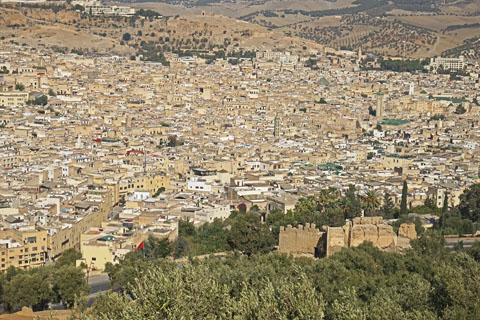
 Fes Medina from surrounding hills. The mosque in the middle dates to 750 CE. Fes Medina from surrounding hills. The mosque in the middle dates to 750 CE.
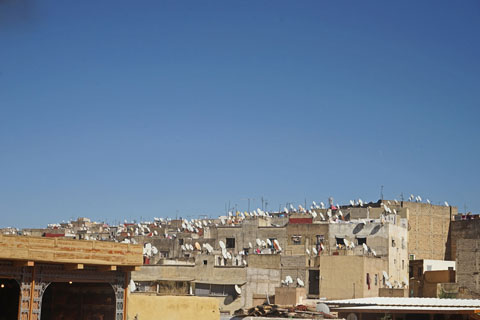
 Although 1500 years old, every building is connected to the world. Although 1500 years old, every building is connected to the world.

 Donkey, carrying hides to the tannery has the right of way. Donkey, carrying hides to the tannery has the right of way.
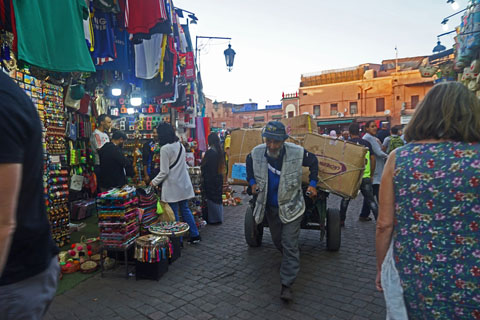
 Human carts are a popular mode of transportation Human carts are a popular mode of transportation

 Donkey power Donkey power
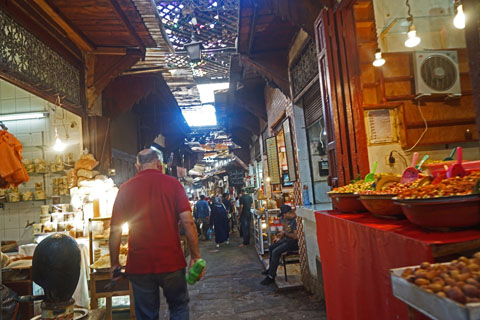
 Food market, or souk Food market, or souk

 Nuts, dates, spices, and transportation cart Nuts, dates, spices, and transportation cart

 Meat market Meat market

 Book seller Book seller
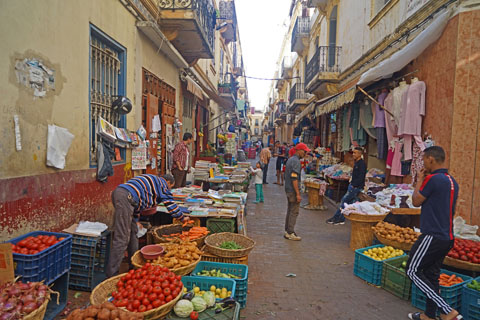
 Typical medina street Typical medina street
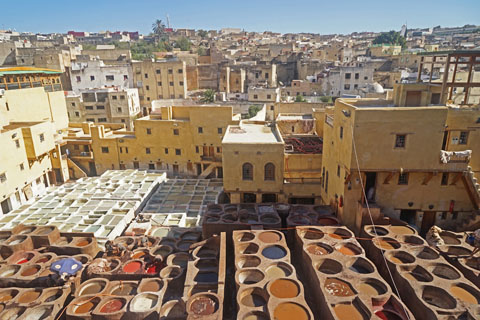
 Oldest working tannery in the world Oldest working tannery in the world
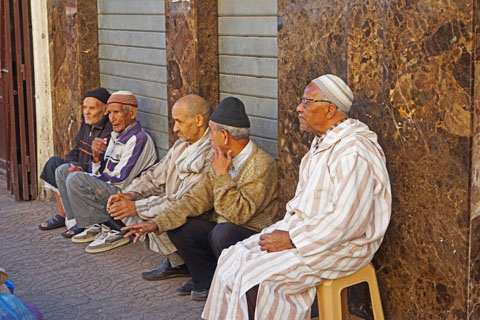
 Elderly gentlemen watching the street action Elderly gentlemen watching the street action

 Different ethnicities Different ethnicities

 Young and old Young and old

|

|

Announcements
Answered: What's Next for Carfree Times?
My thanks to the dozens of people who answered my request for a little feedback on Carfree Times. Most of the responses were a good deal longer than just a sentence, and this has given me a good sense of how people use it and that it's still important to them. This was in no way a statistically-valid study, but that doesn't matter.
In fact, all of the respondents encouraged me to carry on with publication. There was general but not quite universal support for sticking to the core issue of carfree cities and letting other media handle the rest. A lot of people specifically mentioned how much they enjoyed the Photo Essays that have run in almost every issue for some time now, so I'll try to keep them coming. (See the adjacent Photo Essay on Fes in Morocco by Robin Bassett.)
I have updated the Home page and the Carfree Times index page somewhat to reflect changes in technology and prevailing taste in web site design. If you have any problems with the new design, please do advise.
In any case, here's the next issue. I hope there will be many more to follow.
The Books
Carfree Cities and Carfree Design Manual are widely available from booksellers in Europe and North America.
Video
I will soon begin editing the seven hours of UHD video I shot in Seville, Spain, this winter. The raw footage is stunning. In the mean time, the existing 30 videos continue to draw views. You can find them on YouTube.
You can also use the Carfree channel at Vimeo: Carfree.
If you watch a video, please Like it.

Quote of the Quarter
"There has been a fall across the board in the number of Americans holding driving licences, but the shift has been most marked among young people. As Deborah Murphy jokes, a few years ago non-drivers were considered 'car-less,' now they're 'car-free'."

News Bits
The links below will open in a new browser window or tab, depending on your browser; (Ctrl+click) may behave differently:
"The Trend Toward Car-Free Cities Is Picking Up Speed" (Blueprint.cbre.com)
"Pedestria: An Autoless City" (AutolessCity.com)
Doug Windes sent me the above link to his web site. Some items will seem quite familiar to readers of my work, and some won't. It is in any case good to see others taking up the idea of carfree cities.
"Zaha Hadid Architects Propose to Pedestrianize London" (BlouinArtInfo.com)
I was pretty surprised to read this, as the Hadid firm is not high on my list of favored architects, but somebody at the firm does get it.
All over the world, we are observing the trend towards pedestrianising whole districts rather than individual streets. Zaha Hadid Architects proposes "Walkable London," a full-scale network of pedestrian routes which will create corridors of activation across the capital. Transforming just a few streets will hardly make a big difference in terms of congestion, pollution, safety, public health, economic benefits, and social capital. To make walking part of a daily routine, we need a full pedestrian network as an integral part of the city's transport infrastructure.
See also:
"New map and images by leading UK architects reveal network of proposed car-free zones across London" (Standard.co.uk)
"South Korea is building a $35 billion city designed to eliminate the need for cars" (BusinessInsider.nl)
That doesn't make it carfree. It's mainly high-rises with too much green space between them, so most of it won't feel like a comfortable carfree city, either. Still, exploration of alternatives to the auto-centric city is always of interest.
"China's Shanghai sets population at 25 million to avoid 'big city disease'" (TheGuardian.com)
By 2035, the resident population in Shanghai will be controlled at around 25 million and the total amount of land made available for construction will not exceed 3,200 square kilometres.
For comparison, the Reference Design for Carfree Cities is built on a plot of land 16km on a side, or 256 square kilometers, but only 20% of the site is built upon. The population is one million, giving a population density of 39 people per hectare (over the entire site). By contrast, Shanghai would have a population of 78 per hectare.
"50 years since Sicily's earthquake, an urban disaster of a different kind" (TheGuardian.com)
Disaster recovery done wrong, as it often is.
"Tech Envisions the Ultimate Start-Up: An Entire City" [Not for Android] (Pocket.co)
Utopian city-building schemes have seldom succeeded. What we really need, they say, is to fix the cities we already have, not to set off in search of new ones.
Actually, fixing them is pretty easy.
"How to Design Cities for Children" (CityLab.com)
The article starts by condemning strong anti-teen measures taken in some cities. It goes on to say that facilities need to be distributed, not centralized, so that kids have access to them.
The "good for kids" yardstick is probably the most important measuring stick in the urban-planning toolkit, because if it's good for kids, it probably works well for old folks, and, really, for everybody.
"What would the ultimate child-friendly city look like?" (TheGuardian.com)
Worth a read. The answer is, in any case, "Not much like the cities we have today."
"The case against sidewalks" (Curbed.com)
"How to Make an Attractive City" [YouTube Video]
We've grown good at making many things in the modern world - but strangely the art of making attractive cities has been lost. Here are some key principles for how to make attractive cities once again.
This is worth a look. I am also reminded of Jonathan Hale's The Old Way of Seeing. Why is it that we no longer know how to make beautiful things and sometimes can't even see the difference between beautiful and ugly?
"Density's Next Frontier: The Suburbs" (CityLab.com)
America's real housing problem - and a big part of the solution to it - lies in closer-in single-family-home neighborhoods that were built up during the great suburban boom of the last century, and that have seen little or no new housing construction since they were initially developed.
I have long argued that suburban areas will have to see density increases, probably by a factor of at least four or five. In Carfree Cities I showed how this might be done (see pp. 275-276.) In fact, I can already see the beginnings of this in New Jersey suburbs. When a major renovation occurs, it is usual that the building goes from one story to two and the footprint is often extended as well. Of course, the same small number of people is living on the same amount of land, but at least the principle is being established that denser building is possible.
"Where is the world's densest city?" (TheGuardian.com)
"The UN's Habitat data, collected from national census offices, gives the number one spot to Dhaka, with a density of 44,500 people per sq km."
"America's road trip: will the US ever kick the car habit?" (TheGuardian.com)
"Roads to nowhere: how infrastructure built on American inequality" (TheGuardian.com)
Just more American racism at work. This article will take you to places you have probably never been. "White roads through black bedrooms" pretty much sums it up. Of course, the red-lining practices of the FHA didn't help a bit.
"Gobee.bike pulls out of France due to 'mass destruction' of its dockless bike fleet" (TheGuardian.com)
I'm not sure what to make of this. I have long been a supporter of the "drag-and-drop" bike, but it doesn't seem to be working in France at the moment. It may be a simple as mindless vandalism, but maybe not. China's big cities have been having their own problems with dockless bikes.
"Can Dockless Bikeshare Pump Up Cycling's Diversity?" (CityLab.com)
In Washington, D.C., a slew of private companies are shaking up the bike scene's status quo and drawing riders from the city's African-American community.
"The innovative delivery system transforming Gothenburg's roads" (TheGuardian.com)
It's a simple idea. The Swedish city's Stadsleveransen system pools deliveries for 500 shops and businesses - drastically reducing shopping centre traffic and freeing up once-congested streets for pedestrians and cyclists.
This idea has been around, in one form or another, for many years. It seems that it's finally starting to see some implementations.
"How Uber made San Francisco even more congested" [Dutch] (NRC.nl)
Ride-sharing companies Uber and Lyft were to have made transport more efficient in their home city, but San Francisco has actually become more seriously congested. When the autonomous car is stuck in a traffic jam, then are we going to take the self-flying taxi to work?
Imagine skies full of those things, like a plague of locusts. No Thanks.
See also: "Passenger drones are a better kind of flying car" (Economist.com)
"What Elon Musk Doesn't Get About Urban Transit" (CityLab.com)
Elon Musk is clearly a very smart guy, but there is plenty of stuff that, from his hyper-rich perspective, he doesn't get. You might want to have a look at "The Dangers of Elite Projection, which is "the belief, among relatively fortunate and influential people, that what those people find convenient or attractive is good for the society as a whole."
Musk doesn't want to share a vehicle with "a bunch of random strangers." But the presence of random strangers is what a city is, and what successful transit is. The unique achievement of transit is to transport so many people in so little space with so little labor. Crowding - however much it bothers some people - is the essence of transit's success.
I don't hold with that final statement, if what it means is that passengers can expect to stand routinely. Transit should make it possible for people to find a seat at least 90% of the time, and standing should not be required for more than a few minutes, until a seat becomes available.
"Los Angeles Is Ready for the Next Mobility Revolution" (CityLab.com)
"The city was shaped by the streetcar and was an early adopter of the automobile. What comes next?" This is a discussion of the past, present, and future of LA's transport system. I don't think Elon Musk's "tubes full of Teslas" is going to cut it. It's a longish article but worth a look.
"Eulois Cleckley, Hancock's New Head of Public Works, Lives Car-Free in Denver" (StreetsBlog.org)
"Why do so many U.S. cities have gridded streets?" [YouTube Video]
Many U.S. cities were founded with a street grid. Why? This video describes the historic factors that contributed to the adoption of a grid. This includes influential city designs from Versailles, London, Philadelphia, New York, Chicago, and Reno.
Don't take this as definitive, but it's an interesting look at grids in the USA. See the consideration of urban form in Carfree Design Manual for what I think is a more nuanced discussion.
"Local elections: car free zones damage inner cities, say retailers" (DutchNews.nl)
This argument has been making the rounds since before the first modern carfree project was implemented. In places where carfree zones have taken hold, you would never get agreement to allow cars again. It's true that they have not been universally successful, and that's worth a PhD to somebody.
"Overstretched cities: The 100 million city: is 21st century urbanisation out of control?" (TheGuardian.com)
Extreme growth is anticipated in cities in Asia and Africa in this century. Why not build at least some of the expansions as carfree cities? Cheaper, cleaner, you know, better.

About Carfree Times
Next Issue
The next issue of Carfree Times is scheduled for June 2018.
Subscribe to Carfree Times
Carfree Times is published quarterly at Carfree.com.
To receive e-mail notices of new issues, please visit the subscription page or
send e-mail with the word "Subscribe" in the subject line. We do not share our mailing list, except for whatever the spooks may be siphoning off.

Back to Carfree.com
Carfree Times Home
Back to Carfree Times Issue 88
Forward to Carfree Times Issue 90
E-mail
carfree.com
Text and illustrations, except for guest content, placed in the public domain

|